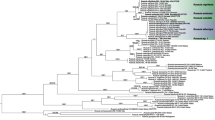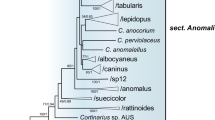Abstract
Seven commonly used Friesian names of Cortinarius sect. Anomali, Spilomei, and Bolares are discussed. Neotypes for C. anomalus, C. spilomeus, and C. bolaris, as well as epitypes for C. albocyaneus, C. caninus, and C. tabularis are proposed. The distinction of these six species is supported by both morphological and rDNA internal transcribed spacer (ITS) data, whereas C. azureus, as currently typified, is considered as a synonym of C. anomalus, but could also be considered as nomen dubium. Barcodes (ITS) and morphological descriptions based on materials from a broad geographical area in Europe are provided for each species. Furthermore, two new species, C. jonimitchelliae and C. pastoralis, from northern Europe are described. The latter is proposed to accommodate C. anomalus subsp. campestris, which has been described from treeless habitats with Helianthemum. Our study reveals that the subsp. campestris is not an intraspecific variety of C. anomalus, but an own species close to C. caninus, and has a much wider distribution and host range than earlier thought. An identification key for the species/sections included here is provided.


Similar content being viewed by others
References
Ammirati J, Garnica S, Halling RE, Mata M, Mueller GM, Carranza J (2007) New Cortinarius species associated with Quercus and Comarostaphylis in Costa Rica. Can J Bot 85:794–812. doi:10.1139/B07-067
Bahram M, Põlme S, Kõljalg U, Tedersoo L (2011) A single European aspen (Populus tremula) tree individual may potentially harbour dozens of Cenococcum geophilum ITS genotypes and hundreds of species of ectomycorrhizal fungi. FEMS Microbiol Ecol 75(2):313–320. doi:10.1111/j.1574-6941.2010.01000.x
Bidaud A, Moënne-Loccoz P, Reumaux P (1992) Atlas des Cortinaires. Pars IV. Fédération Mycologique Dauphiné-Savoie, France
Bidaud A, Reumaux P, Moënne-Loccoz P (1994) Novitates – Validates – Genre Cortinarius. Docums Mycol 24(95):39–45
Bojantchev D (2013) Cortinarius of California: eight new species in subg. Telamonia. Mycotaxon 123:375–402. doi:10.5248/123.375
Borovička J, Bušek B, Mikšík M, Dvořák D, Jeppesen TS, Dima B, Albert L, Frøslev TG (2015) Cortinarius prodigiosus—a new species of the subgenus Phlegmacium from Central Europe. Mycol Progr 14:29. doi:10.1007/s11557-015-1051-1
Brandrud TE, Lindström H, Marklund H, Melot J, Muskos S (1994) Cortinarius, Flora Photographica, Vol. 3. Swedish version. Cortinarius HB, Matfors
Brandrud TE, Lindström H, Marklund H, Melot J, Muskos S (2012) Cortinarius, Flora Photographica, Vol. 5. Swedish version. Cortinarius HB, Matfors
Brandrud TE, Dima B, Schmidt-Stohn G, Bellù F, Frøslev TG, Oertel B, Saar G, Soop K (2014) Cortinarius subgenus Phlegmacium section Multiformes in Europe. Journal JEC 16:162–199
Bulliard P (1789) Herbier de la France, Vol. 9. Paris
Bulliard P (1792) Herbier de la France, Vol. 12. Paris
Consiglio G (2012) Il Genere Cortinarius in Italia. Parte sesta. AMB Fond. Centro Studio Micologici, Trento
Consiglio G, Antonini D, Antonini M (2005) Il Genere Cortinarius in Italia. Parte terza. AMB Fond. Centro Studio Micologici, Trento
Consiglio G, Antonini D, Antonini M (2006) Il Genere Cortinarius in Italia. Parte quarta. AMB Fond. Centro Studio Micologici, Trento
Cripps CL, Liimatainen K, Niskanen T, Dima B, Bishop RF, Ammirati JF (2015) Intercontinental distributions of species of Cortinarius, subgenus Phlegmacium, associated with Populus in western North America. Botany 93:711–721. doi:10.1139/cjb-2015-0089
Dima B, Liimatainen K, Niskanen T, Kytövuori I, Bojantchev D (2014) Two new species of Cortinarius, subgenus Telamonia, sections Colymbadini and Uracei, from Europe. Mycol Progress 13:867–879. doi:10.1007/s11557-014-0970-6
Esteve-Raventós F, Niskanen T, Platas G, Liimatainen K, Ortega A (2014) Cortinarius pseudofallax (Cortinariaceae, Agaricales), the first records from the Iberian Peninsula and Fennoscandia, and taxonomic notes on the C. parvannulatus/cedriolens group. Mycol Progress 13:393–398. doi:10.1007/s11557-013-0925-3
Fries EM (1818) Observationes Mycologicae 2. Bonnier, Copenhagen, Denmark
Fries EM (1821) Systema mycologicum. Uppsala, Sweden
Fries EM (1838) Epicrisis systematis mycologici seu synopsis Hymenomycetum. Regiae Academiae Typographia, Uppsala, Sweden
Fries EM (1863) Monographia Hymenomycetum Sueciae 2. C.A. Leffler, Uppsala, Sweden
Frøslev TG, Jeppesen TS, Læssøe T, Kjøller R (2007) Molecular phylogenetics and delimitation of species in Cortinarius section Calochroi (Basidiomycota, Agaricales) in Europe. Mol Phylogenet Evol 44:217–227. doi:10.1016/j.ympev.2006.11.013
Gardes M, Bruns TD (1993) ITS primers with enhanced specificity for basidiomycetes—application to the identification of mycorrhizae and rusts. Mol Ecol 2:113–118. doi:10.1111/j.1365-294X.1993.tb00005.x
Garnica S, Weiß M, Oertel B, Oberwinkler F (2005) A framework for a phylogenetic classification in the genus Cortinarius (Basidiomycota, Agaricales) derived from morphological and molecular data. Can J Bot 83:1457–1477. doi:10.1139/b05-107
Garnica S, Spahn P, Oertel B, Ammirati J, Oberwinkler F (2011) Tracking the evolutionary history of Cortinarius species in section Calochroi, with transoceanic disjunct distributions. BMC Evol Biol 11:213. doi:10.1186/1471-2148-11-213
Garnica S, Schön ME, Abarenkov K, Riess K, Liimatainen K, Niskanen T, Dima B, Soop K, Frøslev TG, Jeppesen TS, Peintner U, Kuhnert-Finkernagel R, Brandrud TE, Saar G, Oertel B, Ammirati JF (2016) Determining threshold values for barcoding fungi: lessons from Cortinarius (Basidiomycota), a highly diverse and widespread ectomycorrhizal genus. FEMS Microbiol Ecol 92(4): doi: 10.1093/femsec/fiw045
Gouy M, Guindon S, Gascuel O (2010) SeaView version 4: a multiplatform graphical user interface for sequence alignment and phylogenetic tree building. Mol Biol Evol 27:221–224
Harrower E, Ammirati JF, Cappuccino AA, Ceska O, Kranabetter JM, Kroeger P, Lim S, Taylor T, Berbee ML (2011) Cortinarius species diversity in British Columbia and molecular phylogenetic comparison with European specimen sequences. Botany 89:799–810. doi:10.1139/b11-065
Knudsen H, Vesterholt J (2012) Funga Nordica. Agaricoid, boletoid, clavarioid, cyphelloid and gastroid genera. Nordsvamp, Copenhagen
Kõljalg U, Nilsson RH, Abarenkov K, Tedersoo L, Taylor AFS, Bahram M, Bates ST, Bruns TD, Bengtsson-Palme J, Callaghan TM, Douglas B, Drenkhan T, Eberhardt U, Dueñas M, Grebenc T, Griffith GW, Hartmann M, Kirk PM, Kohout P, Larsson E, Lindahl BD, Lücking R, Martín MP, Matheny PB, Nguyen NH, Niskanen T, Oja J, Peay KG, Peintner U, Peterson M, Põldmaa K, Saag L, Saar I, Schüßler A, Scott JA, Senés C, Smith ME, Suija A, Taylor DL, Telleria MT, Weiß M, Larsson K-H (2013) Towards a unified paradigm for sequence-based identification of fungi. Mol Ecol 22(21):5271–5277. doi:10.1111/mec.12481
Konrad P, Maublanc A (1930) Icones selectae fungorum VI. Lechaevalier, Paris
Liimatainen K, Niskanen T, Ammirati JF, Kytövuori I, Dima B (2014a) Cortinarius, subgenus Telamonia, section Disjungendi, cryptic species in North America and Europe. Mycol Progress 14:1016. doi:10.1007/s11557-014-1016-9
Liimatainen K, Niskanen T, Dima B, Kytövuori I, Ammirati JF, Frøslev TG (2014b) The largest type study of Agaricales species to date: bringing identification and nomenclature of Phlegmacium (Cortinarius) into the DNA era. Persoonia 33:98–140. doi:10.3767/003158514X684681
Lindström H (2012) Subgen. Telamonia sect. Anomali. In: Knudsen H, Vesterholt J (eds) Funga Nordica: agaricoid, boletoid, clavarioid, cyphelloid and gastroid genera. Nordsvamp, Copenhagen, pp 837–840
Lindström H, Soop K (1999) Quelques petits Telamonia calciphiles. Journal JEC 1:40–60
Löytynoja A, Goldman N (2005) An algorithm for progressive multiple alignment of sequences with insertions. Proc Natl Acad Sci U S A 102:10557–10562. doi:10.1073/pnas.0409137102
Löytynoja A, Goldman N (2008) Phylogeny-aware gap placement prevents errors in sequence alignment and evolutionary analysis. Science 320:1632–1635. doi:10.1126/science.1158395
Melot J (2007) Interprétation et typification de quelques espèces friésiennes critiques ou peu connues du genre Cortinarius. Journal JEC 9:112–124
Moser M (1970) Cortinarius Fr., Untergattung Leprocybe subgen. nov., die Rauhköpfe. Vorstudien zu einer Monographie (Fortsetzung). Z Pilzk 36(1–2):19–39
Moser M (1983) Die Röhrlinge und Blätterpilze. In: Gams H (ed) Kleine Kryptogamenflora, Band II b/2, 5th edn. Fischer Verlag, Germany
Niskanen T, Kytövuori I, Liimatainen K (2009) Cortinarius sect. Brunnei (Basidiomycota, Agaricales) in North Europe. Mycol Res 113:182–206. doi:10.1016/j.mycres.2008.10.006
Niskanen T, Kytövuori I, Liimatainen K (2011) Cortinarius sect. Armillati in northern Europe. Mycologia 103:1080–1101. doi:10.3852/10-350
Niskanen T, Liimatainen K, Ammirati JF (2013a) Five new Telamonia species (Cortinarius, Agaricales) from western North America. Botany 91:478–485. doi:10.1139/cjb-2012-0292
Niskanen T, Kytövuori I, Liimatainen K, Lindström H (2013b) The species of Cortinarius, section Bovini, associated with conifers in northern Europe. Mycologia 105(4):977–993. doi:10.3852/12-320
Olariaga I, Van Vooren N, Carbone M, Hansen K (2015) A monograph of Otidea (Pyronemataceae, Pezizomycetes). Persoonia 35:166–229. doi:10.3767/003158515X688000
Örstadius L, Ryberg M, Larsson E (2015) Molecular phylogenetics and taxonomy in Psathyrellaceae (Agaricales) with focus on psathyrelloid species: introduction of three new genera and 18 new species. Mycol Progress 14:25. doi:10.1007/s11557-015-1047-x
Osmundson TW, Robert VA, Schoch CL, Baker LJ, Smith A, Robich G, Mizzan L, Garbelotto MM (2013) Filling gaps in biodiversity knowledge for macrofungi: contributions and assessment of an herbarium collection DNA barcode sequencing project. PLoS One 8(4), e62419. doi:10.1371/journal.pone.0062419
Peintner U, Bougher NL, Castellano MA, Moncalvo J-M, Moser MM, Trappe JM, Vilgalys R (2001) Multiple origins of sequestrate fungi related to Cortinarius (Cortinariaceae). Amer J Bot 88(12):2168–2179
Peintner U, Moncalvo J-M, Vilgalys R (2004) Toward a better understanding of the infrageneric relationships in Cortinarius (Agaricales, Basidiomycota). Mycologia 96:1042–1058. doi:10.2307/3762088
Schoch C, Robbertse B, Robert V et al (2014) Finding needles in haystacks: linking scientific names, reference specimens and molecular data for Fungi. Database bau061. doi:10.1093/database/bau061
Silvestro D, Michalak I (2012) raxmlGUI: a graphical front-end for RAxML. Organ Div Evol 12:335–337. doi:10.1007/s13127-011-0056-0
Sowerby J (1797) Coloured figures of English fungi or mushrooms. J. Davis, London
Stamatakis A (2014) RAxML version 8: a tool for phylogenetic analysis and post-analysis of large phylogenies. Bioinformatics 30:1312–1313. doi:10.193/bioinformatics/btu033
Stensrud ØY, Orr RJS, Reier-Røberg KJ, Schumacher TR, Høiland KL (2014) Phylogenetic relationships in Cortinarius with focus on North European species. Karstenia 54:57–71
Tamura K, Stecher G, Peterson D, Filipski A, Kumar S (2013) MEGA6: molecular evolutionary genetics analysis version 6.0. Mol Biol Evol 30:2725–2729. doi:10.1093/molbev/mst197
Thiers B (continuously updated) Index Herbariorum: a global directory of public herbaria and associated staff. New York Botanical Garden’s Virtual Herbarium. Home page at: http://sweetgum.nybg.org/ih/
White TJ, Bruns T, Lee S, Taylor J (1990) Amplification and direct sequencing of fungal ribosomal RNA genes for phylogenetics. In: Innis MA, Gelfand DH, Sninsky JJ, White TJ (eds) PCR protocols: a guide to methods and applications. Academic Press, New York, pp 315–322
Acknowledgments
This study was partly supported by the Societas pro Fauna et Flora Fennica grant. We thank the curators of G, H, PRM, and S for managing the loans of specimens. We are grateful to Gábor M. Kovács (Eötvös Loránd University, Hungary) for allowing us to sequence several Anomali collections in the lab of the Department of Anatomy, Eötvös Loránd University and for his valuable comments on the manuscript. Anna-Lena Anderberg (Swedish Museum of Natural History) is warmly thanked for providing photos of unpublished icones of Fries. We thank Jacques Melot and Tor Erik Brandrud (NINA, Norway) for the valuable discussions and for helping us to get access to literature data. We also thank László Albert, Jan Holec (PRM), and Hans Marklund for providing their photos for publication. Eszter Abádi, László Albert, and Günter Saar are acknowledged for providing collections to this study.
Author information
Authors and Affiliations
Corresponding author
Additional information
Section Editor: Zhu-Liang Yang
Bálint Dima and Håkan Lindström contributed equally to this work.
Rights and permissions
About this article
Cite this article
Dima, B., Lindström, H., Liimatainen, K. et al. Typification of Friesian names in Cortinarius sections Anomali, Spilomei, and Bolares, and description of two new species from northern Europe. Mycol Progress 15, 903–919 (2016). https://doi.org/10.1007/s11557-016-1217-5
Received:
Revised:
Accepted:
Published:
Issue Date:
DOI: https://doi.org/10.1007/s11557-016-1217-5




